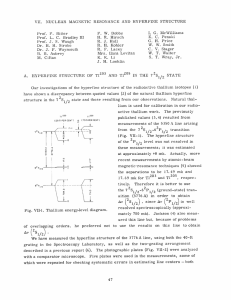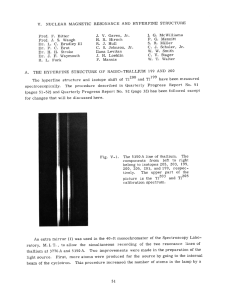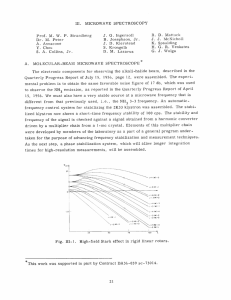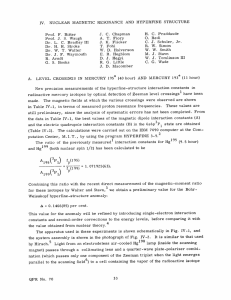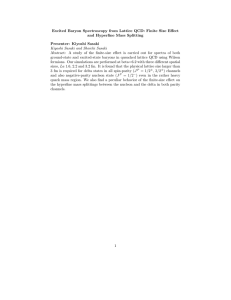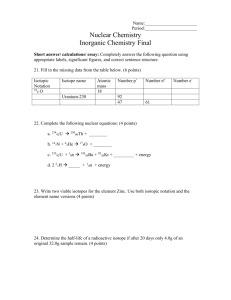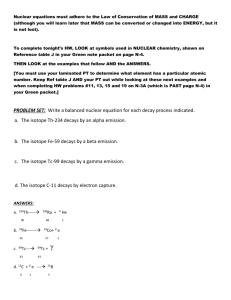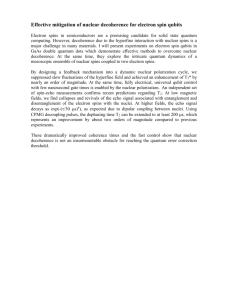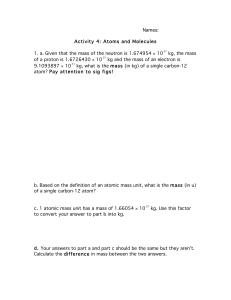VII. NUCLEAR MAGNETIC RESONANCE AND HYPERFINE ... Prof. F. Bitter R. L. Fork
advertisement
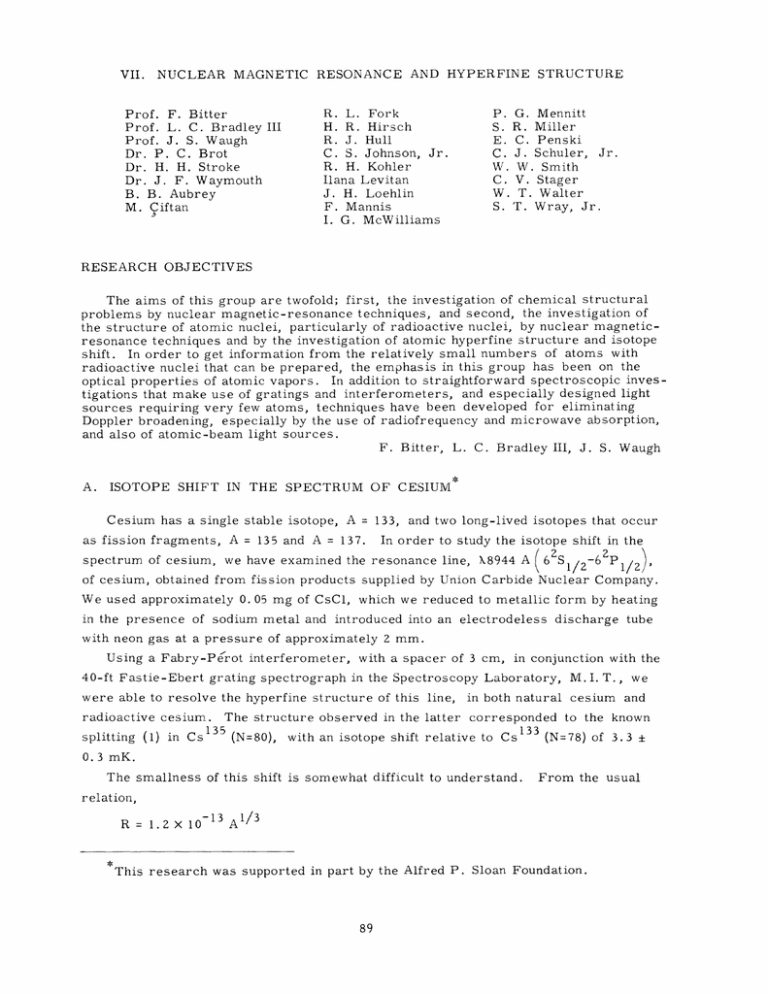
VII. NUCLEAR MAGNETIC RESONANCE AND HYPERFINE STRUCTURE Prof. F. Bitter Prof. L. C. Bradley III Prof. J. S. Waugh Dr. P. C. Brot Dr. H. H. Stroke Dr. J. F. Waymouth B. B. Aubrey M. Ciftan 3I. R. L. Fork H. R. Hirsch R. J. Hull C. S. Johnson, Jr. R. H. Kohler Ilana Levitan J. H. Loehlin F. Mannis G. McWilliams P. S. E. C. W. C. W. S. G. R. C. J. W. V. T. T. Mennitt Miller Penski Schuler, Jr. Smith Stager Walter Wray, Jr. RESEARCH OBJECTIVES The aims of this group are twofold; first, the investigation of chemical structural problems by nuclear magnetic-resonance techniques, and second, the investigation of the structure of atomic nuclei, particularly of radioactive nuclei, by nuclear magneticresonance techniques and by the investigation of atomic hyperfine structure and isotope shift. In order to get information from the relatively small numbers of atoms with radioactive nuclei that can be prepared, the emphasis in this group has been on the optical properties of atomic vapors. In addition to straightforward spectroscopic investigations that make use of gratings and interferometers, and especially designed light sources requiring very few atoms, techniques have been developed for eliminating Doppler broadening, especially by the use of radiofrequency and microwave absorption, and also of atomic-beam light sources. F. Bitter, L. C. Bradley III, J. S. Waugh A. ISOTOPE SHIFT IN THE SPECTRUM OF CESIUM Cesium has a single stable isotope, A = 133, as fission fragments, A = 135 and A = 137. and two long-lived isotopes that occur In order to study the isotope shift in the spectrum of cesium, we have examined the resonance line, X8944 A ( 6ZS 1 / 2 6 2P 1 / 2 ), of cesium, obtained from fission products supplied by Union Carbide Nuclear Company. We used approximately 0. 05 mg of CsC1, which we reduced to metallic form by heating in the presence of sodium metal and introduced into an electrodeless discharge tube with neon gas at a pressure of approximately 2 mm. Using a Fabry-Perot interferometer, with a spacer of 3 cm, in conjunction with the 40-ft Fastie-Ebert grating spectrograph in the Spectroscopy Laboratory, M. I. T., were able to resolve the hyperfine structure of this line, radioactive cesium. splitting (1) in Cs we in both natural cesium and The structure observed in the latter corresponded to the known 13 5 (N=80), with an isotope shift relative to Cs 133 (N=78) of 3.3 0.3 mK. The smallness of this shift is somewhat difficult to understand. From the usual relation, R = 1.Z X 10 - 1 3 A 1/ 3 This research was supported in part by the Alfred P. Sloan Foundation. + (VII. NUCLEAR MAGNETIC RESONANCE) we would predict a shift of 25 mK; the distortion computed from the known quadrupole moment (2) of Cs 133 , 0. 003 approximately one part in 105. 0. 002 X 10 -24 2 cm , is expected to reduce (3) this only The most likely inference would seem to be that as one approaches a closed shell of neutrons (N=82), the nuclear density increases somewhat, although it may be that the mass effect contributes a significant amount (4). S. T. Wray, Jr., L. C. Bradley III References 1. H. Rev. 105, B. H. Stroke, 590 (1957). V. Jaccarino, 2. H. Bucka, Naturwiss. 3. L. Wilets, 4. A. P. 43, D. S. Jr., and R. Weiss, Phys. 371 (1956). D. L. Hill, and K. W. Stone, Edmonds, Ford, Phys. Rev. 91, 1488 (1953). Proc. Phys. Soc. (London) 74, 424 (1959). ATOMIC-BEAM ABSORPTION CELL An atomic-beam apparatus has been constructed for the purpose of studying more precisely the hyperfine structure of the thallium 3776 A 7 2 S 1 / 2 -6 2 P 1/ 2 ) resonance line, and, eventually, the 5350 A 72S1/2-6 2 3/2 information on the isotope shifts in the 2 p hfs anomaly in the line. 2 The results are expected to yield and 2P3/2 states, as well as a possible S 1/2 state between the two stable Tl isotopes. Absorption has been observed only in the strongest component of the 3776 A line by using a Fabry-Perot interferometer. The beam, however, was not completely satisfactory because the absorption was less than was expected, these difficulties, and the linewidth greater. In order to overcome a more intense atomic beam with a channel oven has been constructed. Further details are given in M. Ciftan's thesis (1). M. Ciftan, L. C. Bradley III, H. H. Stroke References 1. M. Ciftan, Development of atomic-beam apparatus for absorption or emission spectroscopy, S.M. Thesis, Department of Physics, M.I. T., September 1959. C. MECHANICAL IMPROVEMENTS IN A HIGH-POWER MICROWAVE ATTENUATOR Movable water loads provide a practical means of obtaining variable microwave attenuation at power levels of 50 watts, and upward. The water load is a dielectric tank through which a mixture of ethylene glycol and water is pumped. When it is placed in a waveguide carrying rf power, the power is absorbed directly in the liquid. The (VII. NUCLEAR MAGNETIC CRANK RESONANCE) SHIELD CAN GEARS -. TO PUMP REW HOSES --NUT EXCHANGER PYREX WATER LOAD WAVEGUIDE Fig. VII-1. Attenuator. liquid is cooled by being pumped through an external heat exchanger. The attenuation is increased, either by moving the load from a low field to a high field region or by inserting it progressively through a slot in a wall of the waveguide. Although variable water-load attenuators are ideal for high-power applications, they are not commercially available at the present time. Experience has shown that the polystyrene water loads, which have been used thus far, gradually deteriorate under the action of ethylene glycol, and warp badly if they are subjected to even a slight excess The useful life of a load is approximately 6 months, and replacements are far from easy to fabricate. Moreover, the necessity for minimizing stray radiation has led to complicated mechanisms for varying the attenuation, and these have failed to of heat. provide adequate protection for the delicate water load. A 3-kmc attenuator has been constructed (Fig. VII-1) which is relatively simple, The load itself is made of Pyrex. A screw and obviates the difficulties mentioned. A shield can encloses the entire mechlowers it through a slot in the waveguide. anism, isolating it mechanically and electrically. connected to brass tubes passing through the shield, Hoses from the water load are so that tugs on the external hoses to the pump and heat exchanger cannot be transmitted to the Pyrex tank. It was conjectured that the shield might act as a resonant cavity coupled to the waveguide, but no difficulty from this source has been encountered. D. HYPERFINE STRUCTURE OF Hg 201 H. R. Hirsch IN ZERO FIELD 1 201 3 has three components: F - 2 P1 state of Hg The hyperfine structure of the 5 3 . 3 and ? components has 5 . Optically detected microwave resonance between the 2 ' 2 "?1 (VII. NUCLEAR MAGNETIC RESONANCE) been observed. The method is the same as that used to measure the F = -<F 3 2 separation (1, 2). The results of both measurements are: Transition Frequency (mc) F= <- F=-) F= <-> F= Observed Lifetime (sec) 7551. 613 + .013 ) 13,986. 557 = 1 2 0.7 X 10- 7 1. 0 X 10 - 7 . 008 R. H. Kohler References 1. R. H. Kohler, Hyperfine structure of the 3 P1 resonance methods, Quarterly Progress Report, M.I.T., Jan. 15, 1958, p. 39. state of mercury by double- Research Laboratory of Electronics, 2. R. H. Kohler, Hyperfine structure of Hg 2 0 1 in zero field, Quarterly Progress Report No. 55, Research Laboratory of Electronics, M.I.T., Oct. 15, 1959, p. 64. E. HYPERFINE STRUCTURE OF THE The F = 3 <- F = 1 P transition in the 33P magnetic fields (=10 gauss). STATE OF MERCURY state of Hg 199 has been observed in small The methods employed are basically the same as those used by Kohler (1, 2). The previous accepted value (22,118 ± 15 mc) was that obtained by Melissinos (3). Preliminary observations give the splitting as 22,129 ± 0.5 mc. With further modification of the apparatus, and an increase in sensitivity, it is anticipated that the error will be decreased by a factor of 10. C. V. Stager References 1. R. H. Kohler, Hyperfine structure of the 3P1 state of mercury by double- resonance methods, Quarterly Progress Report, Research Laboratory of Electronics, M.I.T., July 15, 1956, p. 20. 2. R. 3. A. Melissinos, H. Kohler, Hyperfine structure of the 3P state of mercury by doubleresonance methods, Quarterly Progress Report, Research Laboratory of Electronics, M.I.T., Jan. 15, 1958, p. 39. a magnetic field, The hyperfine structure of the 6 3p level of natural mercury in S.M. Thesis, Department of Physics, M.I.T., August 1956.
